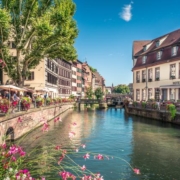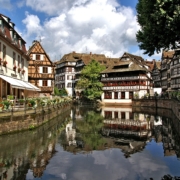The Alsace Wine Road is a route for those who know how to savour life. Instead of rushing between Strasbourg and Colmar, take your time: plan a full day to stop by wineries, taste the best Rieslings, and wander through postcard-worthy villages. And if time is short, you can opt for a short half-day wine tour from Strasbourg.
This route was officially declared a tourist trail in 1953 to boost the local wine economy. It continues the German Wine Route and is rightly considered a true paradise for wine connoisseurs.
» READ MORE – 10 beautiful cities in France just one hour away from Paris
Start with Strasbourg
Stroll through the old town, visit the cathedral, and take a guided tour with a local expert or our author’s audio guide – you’ll see the highlights in just a couple of hours.
Book a car in StrasbourgNext comes the road south. On the way to Colmar, vineyards and wine villages alternate like beads on a string.
The wines produced here are world-famous, but the best way to experience them is on site: fresh, authentic, and far better value for money.
Wissembourg
Just two kilometres from the German border, Wissembourg marks the northernmost point of the Alsace Wine Route. Nestled along the leisurely Wislauter River, this town sets the tone for the entire journey. Special attention should be paid to the architecture.
City tourMedieval churches, the quaint Salt House with its disproportionately high pitched roof, and the famous half-timbered buildings with contrasting exposed beams are architectural hallmarks of Wissembourg. To get in the spirit for the rest of the itinerary, visit the Musée Westercamp, a local history museum.
Obernai
You’ll be hard-pressed to find more half-timbered houses than in Obernai. Every turn begs to be photographed – assuming your phone or camera has enough storage or film.
The main landmarks of Obernai are the Church of Saints Peter and Paul with its twin towers, and the Kappelturm bell tower. The town is so compact that the spires of these historic buildings can be seen from almost anywhere.
After your stroll, stop by one of the cosy restaurants offering Alsatian cuisine and local wines.
Mittelbergheim
Mittelbergheim is known for its medieval churches and artisanal wine-making traditions. The most famous vineyard, Zotzenberg, lies just outside the city walls and produces noble grape varieties such as gewürztraminer, riesling and pinot gris.
There are around two dozen wine houses packed into this small village, so it’s almost impossible to leave Mittelbergheim without picking up a bottle or two.
Château du Haut-Koenigsbourg (Upper Koenigsbourg Castle)
The most renowned castle in Alsace, Château du Haut-Koenigsbourg has withstood numerous wars since its 12th-century construction. Today, it’s tourists, not soldiers, who fill its halls.
Join them – the medieval interiors and the rich collection of Habsburg-era weaponry are well worth your time. From the observation deck beneath the roof of the Great Bastion, you can enjoy a sweeping panorama of the valley and the Vosges Mountains.
Ribeauvillé
Continuing the theme of fortresses, Ribeauvillé deserves a visit. The town rests in the shadow of three majestic castles: St Ulrich, Haut-Ribauvillé and Giersberg. Though now in ruins, they speak volumes about the wealth of their medieval lords. A walk along the surrounding trails reveals the scale of these once-imposing fortifications.
The town also hosts the Kougelhopf almond cake festival at the end of May, where you can sample various versions of this local delicacy.
The town hall features a charming collection of gilded plates and silver cups – gifts from former local lords. Don’t miss the chance to taste wines from Ribeauvillé’s three grand cru vineyards: Geisberg, Kirchberg and Osterberg. Each one is a name to remember.
Riquewihr
Next on the route is Riquewihr. You can walk across the town in ten minutes, but plan to stay at least an hour.
- In summer, the colourful half-timbered houses overflow with flowers
- In winter, the Christmas market takes centre stage
This town in the heart of the Alsatian vineyards boasts many old winemakers’ houses.
Riesling – a grape variety that produces some of the most aromatic and refreshing white wines – is grown here.
Kaysersberg
Kaysersberg is part of the Romanesque Road of Alsace, linking monuments of Romanesque architecture.
Private walking tourThis charming town blends the warmth of a traditional Alsatian village with the clean lines of the Église Sainte-Croix. With its gingerbread-like appearance, Kaysersberg was voted France’s Favourite Village in 2017.
» READ MORE – 10 beautiful villages to visit in Alsace
But the primary reason to come is the wine, crafted here for centuries.
Planning your trip for late August to mid-October? You may get the chance to join the grape harvest.
Winemakers in various villages welcome helpers during the season. In exchange, you’ll learn a few production secrets, taste the final product, and receive a diploma at day’s end — a delightful memento of your adventure.
Ruins of three medieval castles near Egisheim
Colmar is just a short drive away, but we recommend heading slightly further to Egisheim. This village is officially one of France’s «Most Beautiful Villages,» and locals work hard to preserve its heritage.
In summer, the windowsills of the well-kept houses overflow with flowers. The colourful shutters gleam in the sun, and elegant wrought iron signs hang above the shops.
Nearly every courtyard hides a wine cellar, where owners pour their wines made from cherished family recipes.
Above the town, the ruins of three castles – Dagsburg, Walenburg and Weckmund – crown a hill. A trail winds to them through vineyards and forests, and from the summit, you can see across the Alsatian plain.
Munster is home to one of France’s finest cheeses
No wine journey is complete without cheese. One iconic pairing is Munster – a cheese made from the milk of Vosges cows. Its rich taste comes from aging beneath a washed rind treated regularly with brine.
The cheese is named after the town of Munster, where it has been made for more than 1,500 years.
Though not on the traditional Alsace Wine Road, Munster is worth a short detour. Visit the Maison du Fromage, where generations of cheesemakers guide you through every stage of production – and let you taste the results.
We suggest finishing the wine road adventure in the gingerbread town of Colmar, known for its unusual architecture, vibrant festival calendar, and its very own «Little Venice.»






 Hugues de BUYER-MIMEURE / Unsplash
Hugues de BUYER-MIMEURE / Unsplash 


 Filiz Elaerts / Unsplash
Filiz Elaerts / Unsplash  tk tan / Pixabay
tk tan / Pixabay Timelab / Unsplash
Timelab / Unsplash
Leave a Reply
Want to join the discussion?Feel free to contribute!